Proceding up the arroyo the canyon narrows further and GPS readings become more erratic. About 1km past the Venado Gordo site the canyon swings left and heads more west.
There are 3 closely related sites here, each having a collection of art.
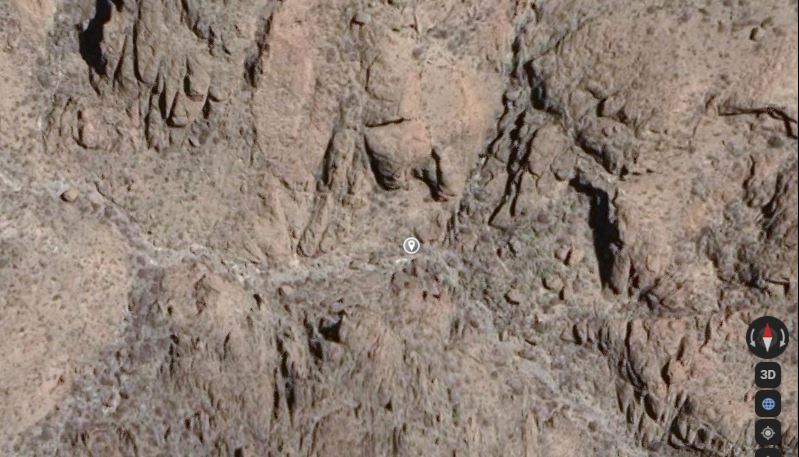
There is a large house sized sloping rock producing an overhang at arroyo level on left at about xxkms from the arroyo Junction and 26.71xxx, 111.95xxx. SB 4R C6 containing significant art. Two other sites are in close proximity; another large house sized rock and the other site, a south facing shelter.
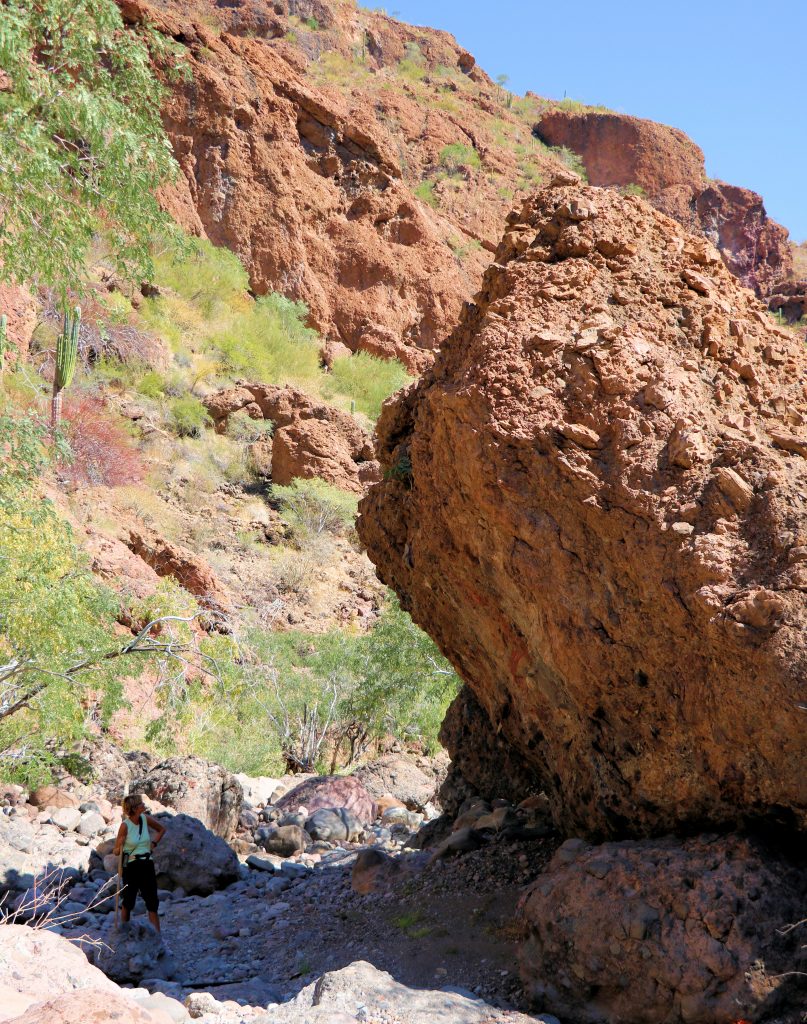
SB 4R C6 “Wall of Man”: is a large north facing sloping rock about 12 meters wide and about 8 meters high composed of volcanic tuft. There is pictograph art on the underside of the sloping north face and also on the vertical east face. No petroglyphs were found at any of the three sites here in this location. The painted art is in red and black and is quite indistinct, probably due to the porous quality of the volcanic tuft. Unfortunately the painted images below about 1.5 meters high have been scoured away by erosion of Chubasco induced waters flowing in the arroyo.
I have to give credit to Bruce and Marian Schweers for being the first to find these incredible paintings and for the better quality images that follow. Camera CMOS size does matter!
Photo of Marian at the ‘Wall of Man’ by Bruce Schweers
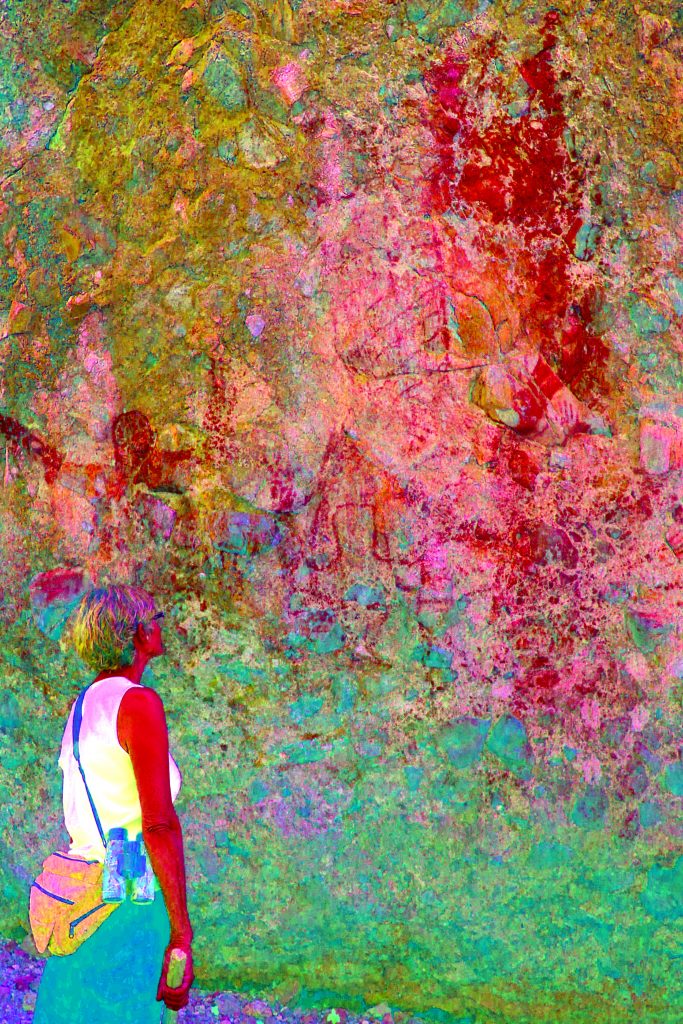
The art of note are nine large anthropomorphs visible from about the waist upwards. All the anthropomorphs are about 1.2 to 1.5 meters tall or more or less full size.
All the photographs have been enhanced using software from Dstretch.com by Jon Harman.
The photo here shows Marian at the Wall of Man and shows relative size of the images.
For ease of description I will refer to the anthropomorphs as Monos.
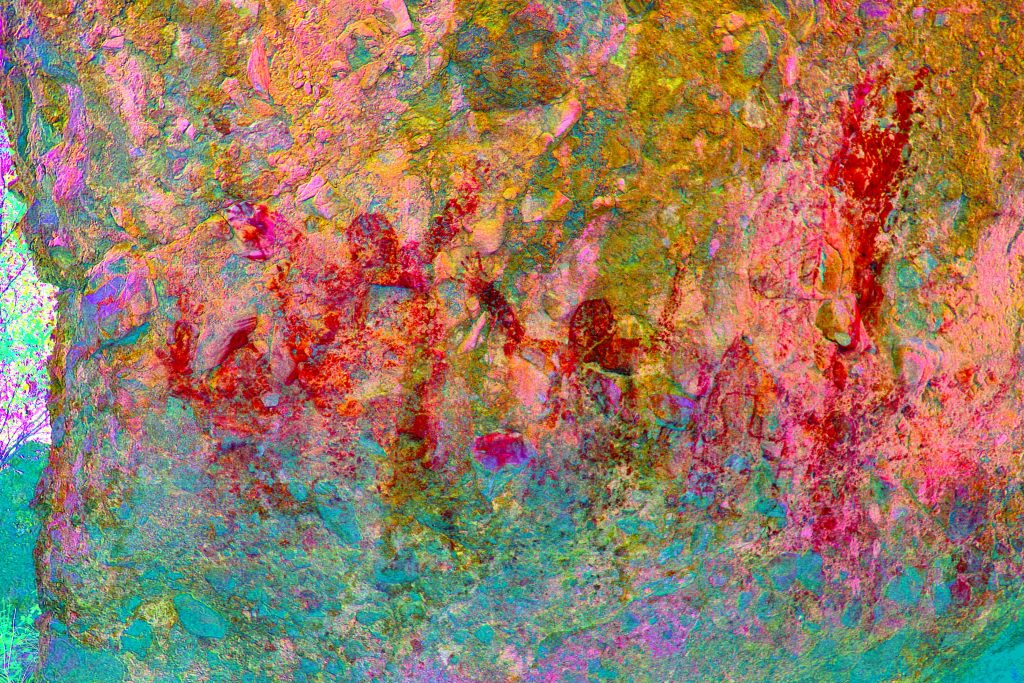
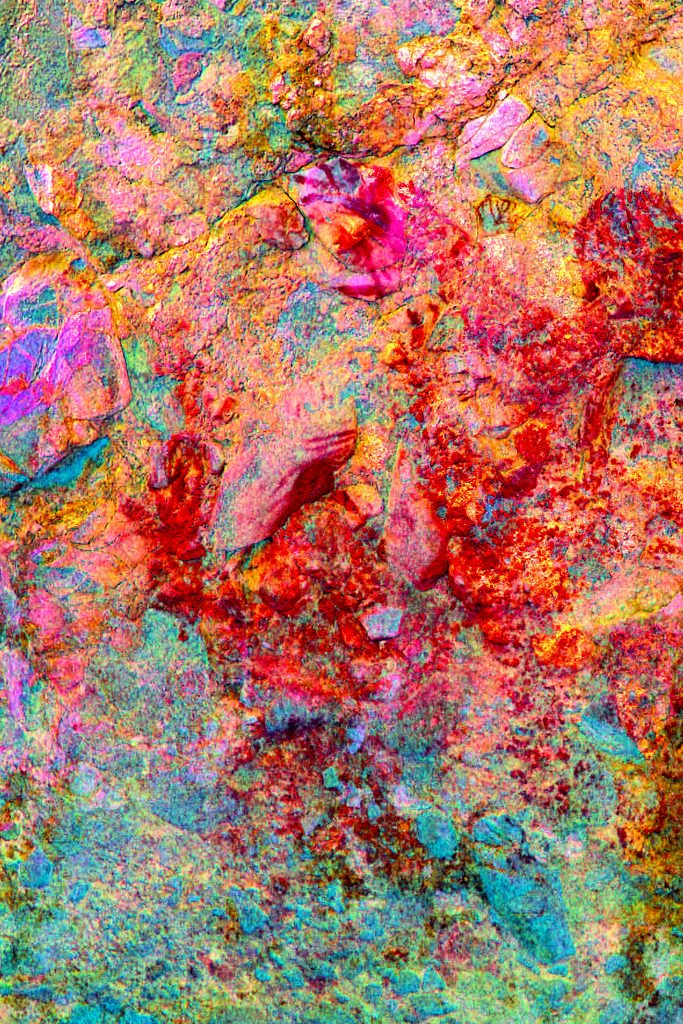
On the main north facing panel, from the left
Mono 1: Red Mono, arms up bent at the elbows, fingers visible, may have headdress. May be horizontal handprint above head. Indistinct below about mid torso. The left arm of this Mono overlaps the torso of #2.
Photo: Mono #1_ac_crgb
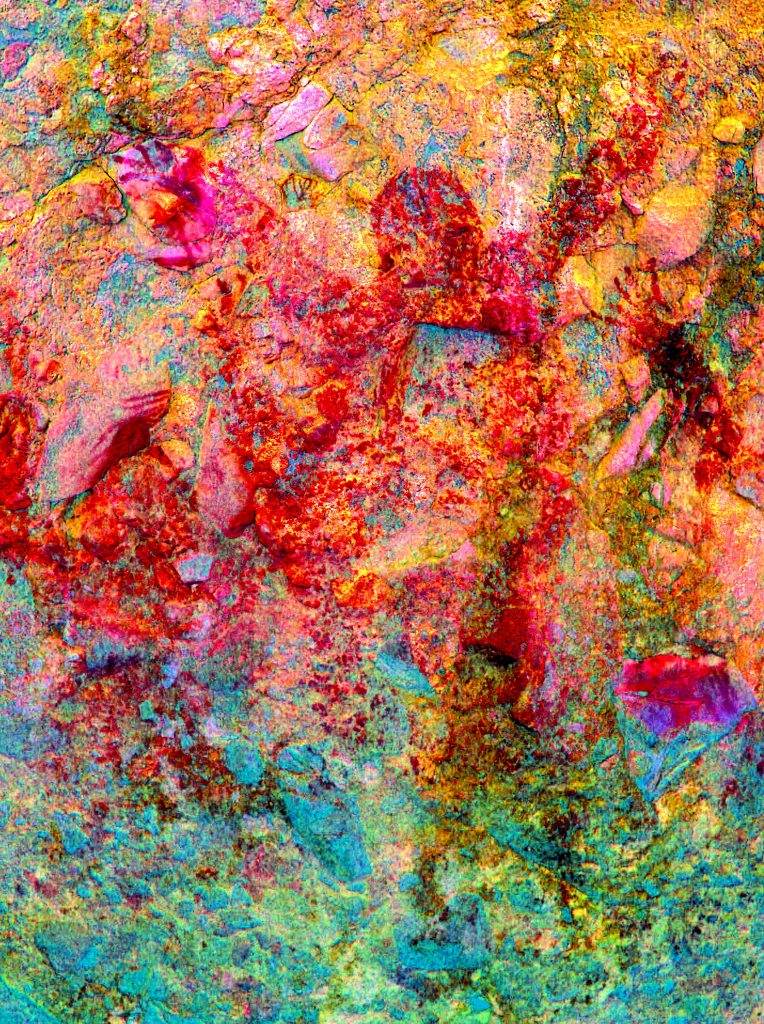
Mono 2: Red Mono, slightly to the right of #1 but positioned about 1 meter higher on the wall. arms up, fully extended and not bent at the elbows. Fingers are clear, five on each hand, thumbs not visible. Round head with vertical black and red lines. No neck. Torso slightly bent to viewers left (obviously an early Socialist!). Legs are not visible and everything below the waist eroded.
Photo: Mono #2_ac_crgb.
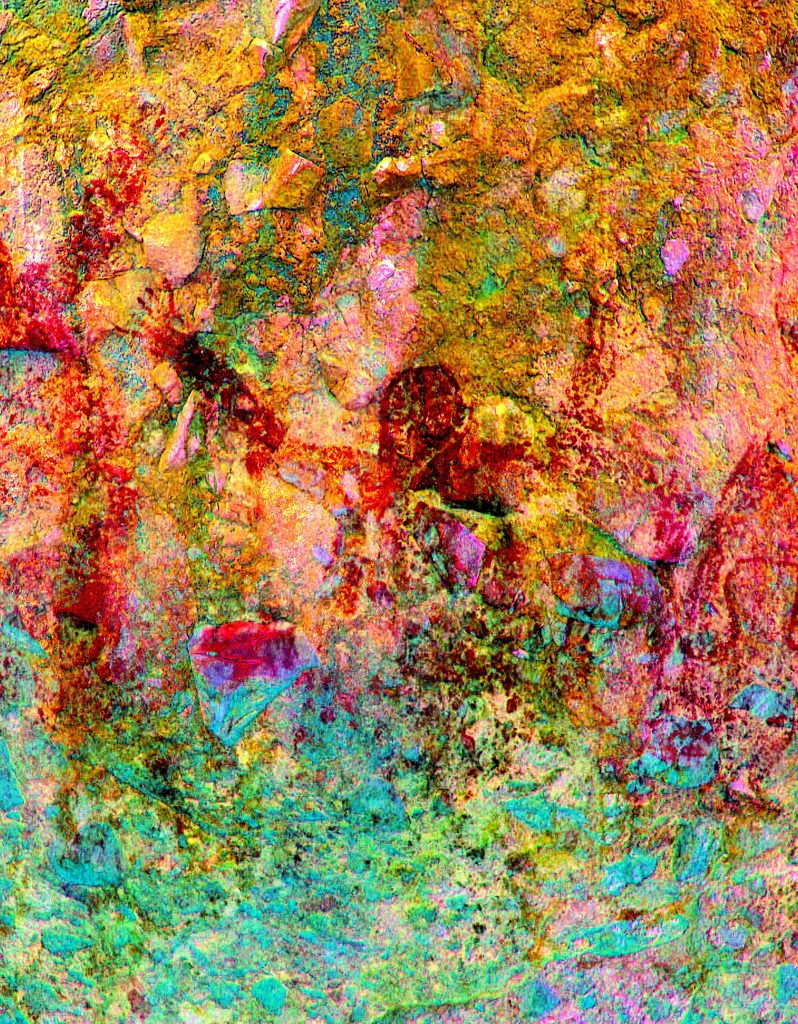
Mono 3: Red Mono, about the same height on the wall as #1. Arms extended, right arm almost fully extended, left arm bent at elbow. Right hand 6 fingers, left hand not clear, may have something round in left hand. Round head, no neck. Legs are not visible and everything below the waist eroded. Indistinct solid red object between #2 and #3 at about waist height.
Photo: Mono #3_ac_crgb.
Immediately to the right of Mono #3 are three elements, two lower elements sharing the same relative space immediately to the right of #3 and the third element immediately above. So. . . .
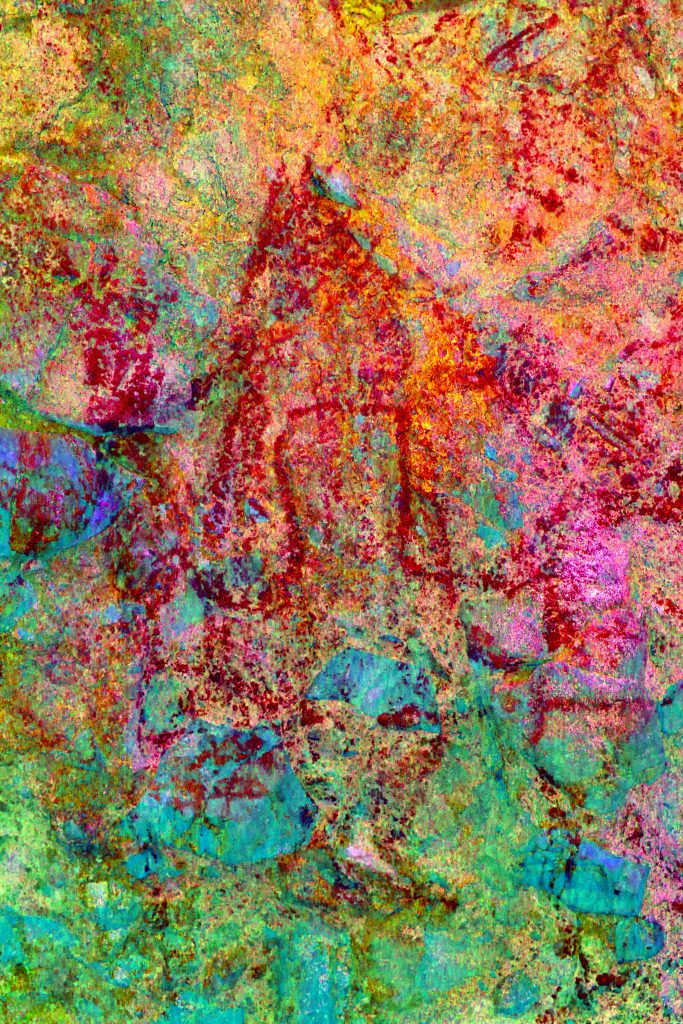
Lower Elements in space #4
Visually in the foreground is a red outlined Mono with a Can head, (Mono #4) right arm upraised, left arm is upraised also but is very faint. There is Dart/Spear penetrating the torso from the right to the left with the point about mid torso. The interior of this Mono is clear and not coloured. In the background of this element is a large fish with the head up and extending about 30cms above the head of the Mono. The tail of the fish is at a point somewhat below the mid torso of the Mono, making the total length of the fish portion about 1.5 meters. The fishes mouth is open. Fish fins can clearly be seen on the left, slightly above the Mono’s head. This fish style is seen in other cave art in the Mulege area and is generally believed to depict a whale. The fish is solidly coloured in red, therefore as the Mono is in front of the fish and is clear, outlined only, both these elements must have been painted at the same time. It has been suggested to me by Jim Workman that this image could represent an entity that can transform itself from Man to Fish and back again. An interesting and complicated abstract concept! Hmm?
Photo: Mono #4_ac_crgb.
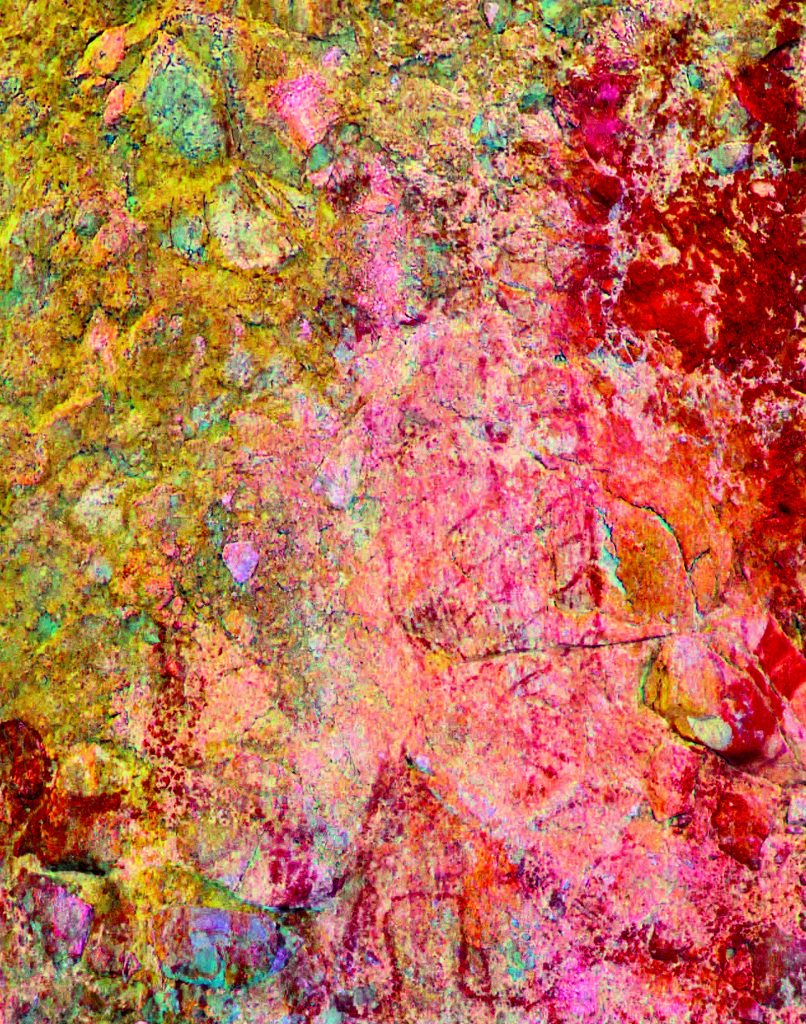
Upper Element in space #4
This Mono (Mono #5) is painted in red outline only and has diagonal cross-hatching marks in the interior of the body and is faint. The head is round or slightly “can head” shaped. There is a neck. There is also a headdress that looks like the floppy ears of a rabbit, one “ear” to each side of the head and about 20cm long. (In San Borjitas style) The Mono’s right arm is extended, no hand visible. There may be an object or bump on the right shoulder. The left arm is not visible and overpainted by another Mono.
Photo: Mono #5_ac_crgb..
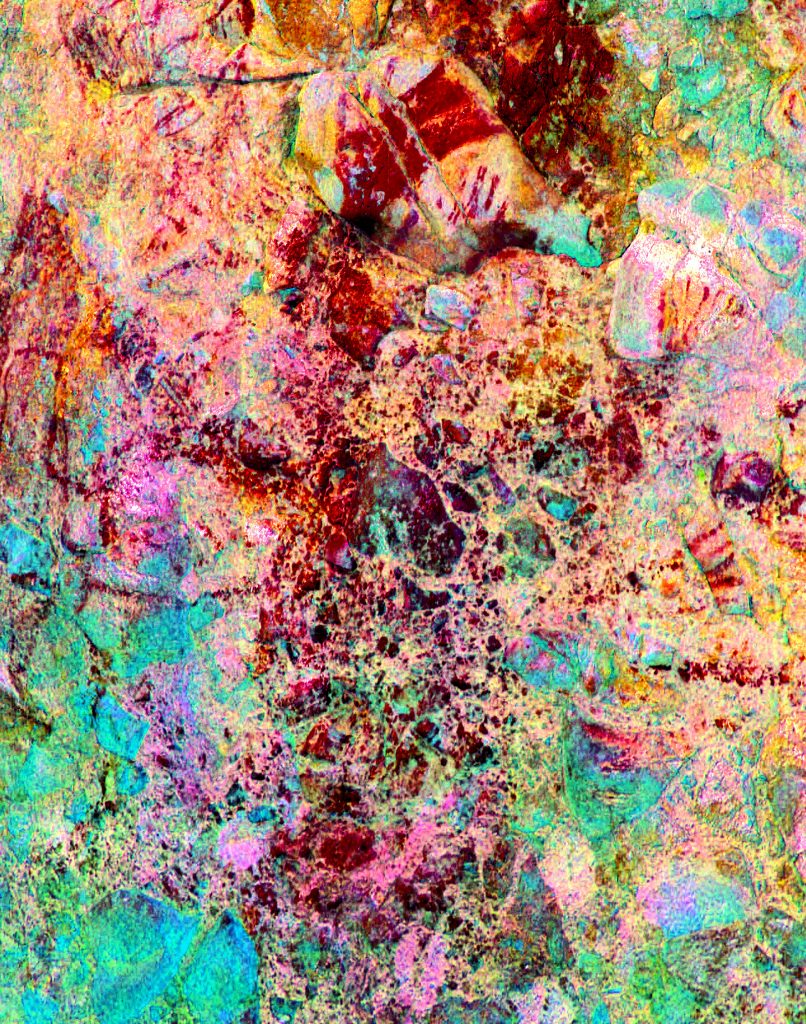
Lower Element in space #5
The lower Mono (Mono #6) is painted in solid red and is visible from about the abdomen up. The visible portion is about 1 meter tall. Both arms are raised and fully extended. The hands, head and shoulders are indistinct. The arrow/spear that is shown with the point in mid torso of Mono #4 may in fact be one that is supposed to be related to this Mono instead. There are three hand prints in close relation to this Mono; one above the head and one on the viewers right side of the Mono at about its waist height. The third hand print is also on the viewers right and may be a fan instead.
Photo: Mono #6_ac_crgb
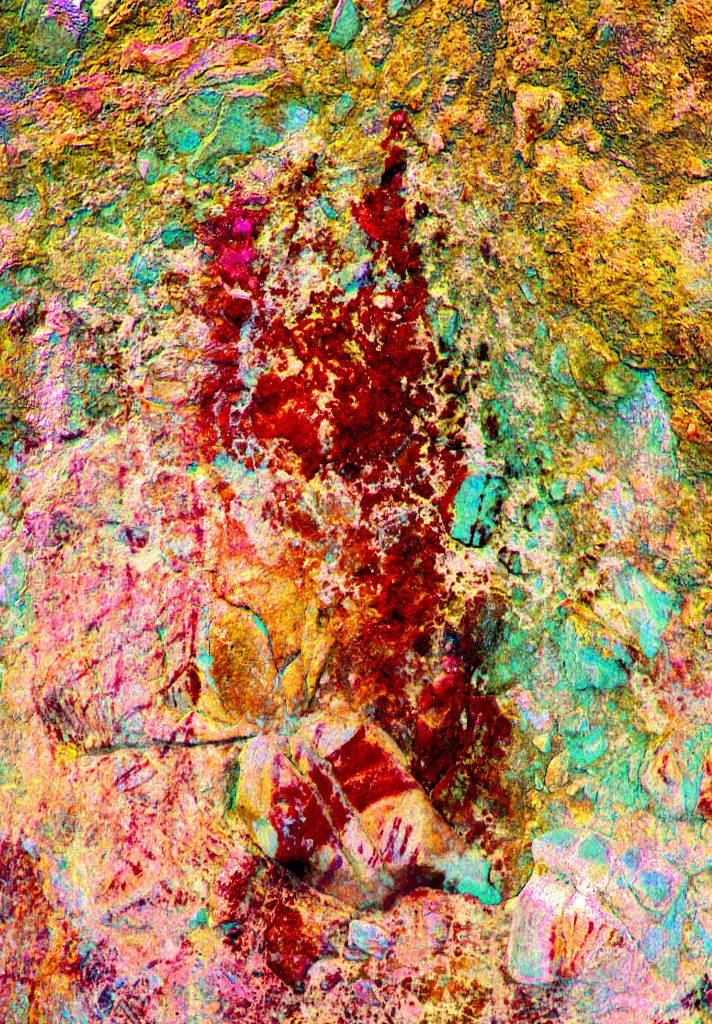
Upper Element in space #5
This upper pictograph is also a Mono (Mono #7) It is about 2 meters tall and is painted in solid red with arms raised. The right arm seems to be bent at the elbow and there may be an object in the right hand. The left arms appears foreshortened and may hold a spear. The end of the spear being about 20cms above the hand. The shape of the head is indistinct but I believe it was originally multicoloured and has subsequently faded through time to leave a patchwork of red. There are red splashes of colour that look like a six point star in the space above where the top of the head would normally be and I suspect this to be the remains of a headdress of some kind.
Photo: Mono #7_ac_crgb.
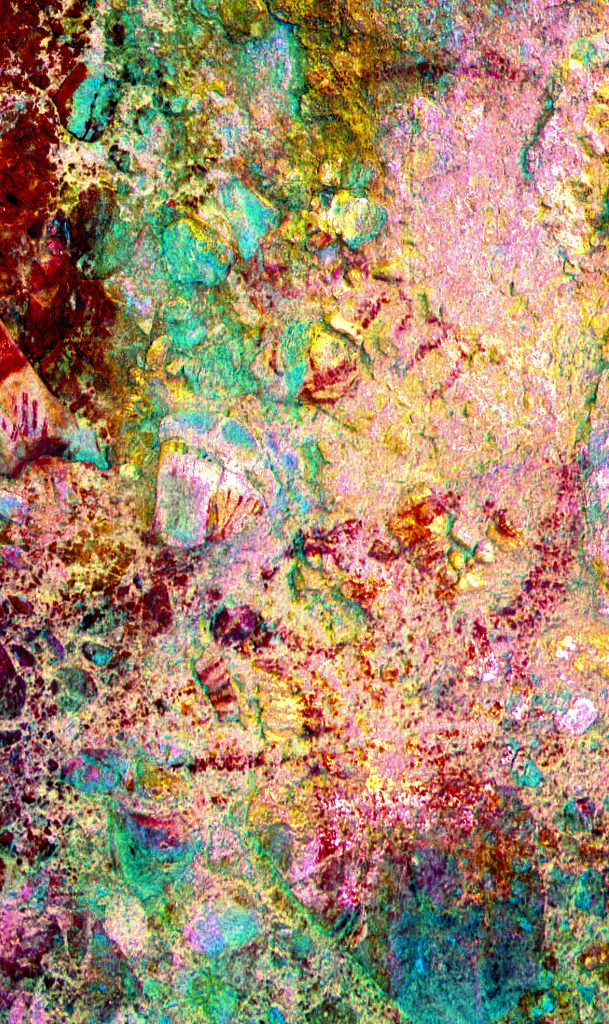
Lower element in Space #6
This element is a Mono (Mono #8) it is about 1.2 meters tall with the portion below mid torso worn away. The Mono is outlined in red and gives the appearance of being coloured in pink in the interior although I expect it was originally painted a solid red but the paint has faded and blends in with the pink colouring of the rock behind (in the enhanced photo). It has a can style head with a headdress of the floppy rabbit ear type extending to each side. The arms are raised with the elbows only slightly bent. The whole upper torso of this mono is tilted to its right (viewers left) with the left arm and hand higher than the right. There is a spear penetrating the Mono at mid torso from right to left. The spear shaft is horizontal.
Photo: Mono #8 and fish_ac_crgb
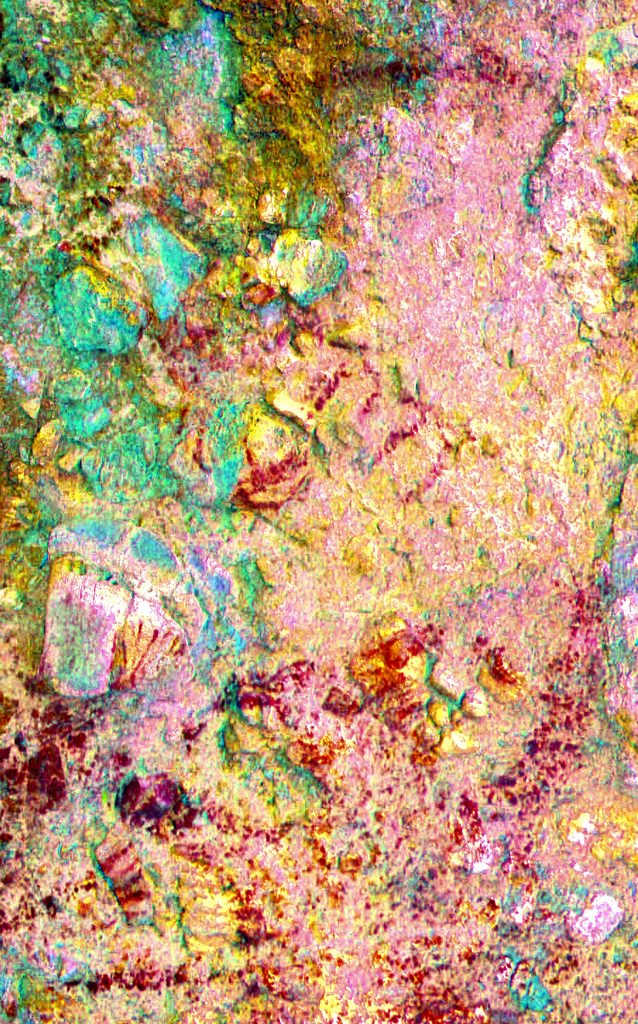
Upper element in Space #6
This element is a fish about 1.5 meters long with the tail up. It appears to be a good likeness to the profile of a Broomtail Grouper. It is outlined in black/brown. It appears to have a pink colouring in the interior. No interior detailing is evident. The mouth of the fish is superimposed over the shoulders of Mono #8 and appears to give that Mono a dark coloured necklace.
Photo: Mono #8 and fish2_ac_crgb
Now we will look at the figure to the left on the adjoining east facing vertical wall. This wall is almost vertical and very rough. The sun will cast light on this surface till local noon. As a result, the figures here are very faded.
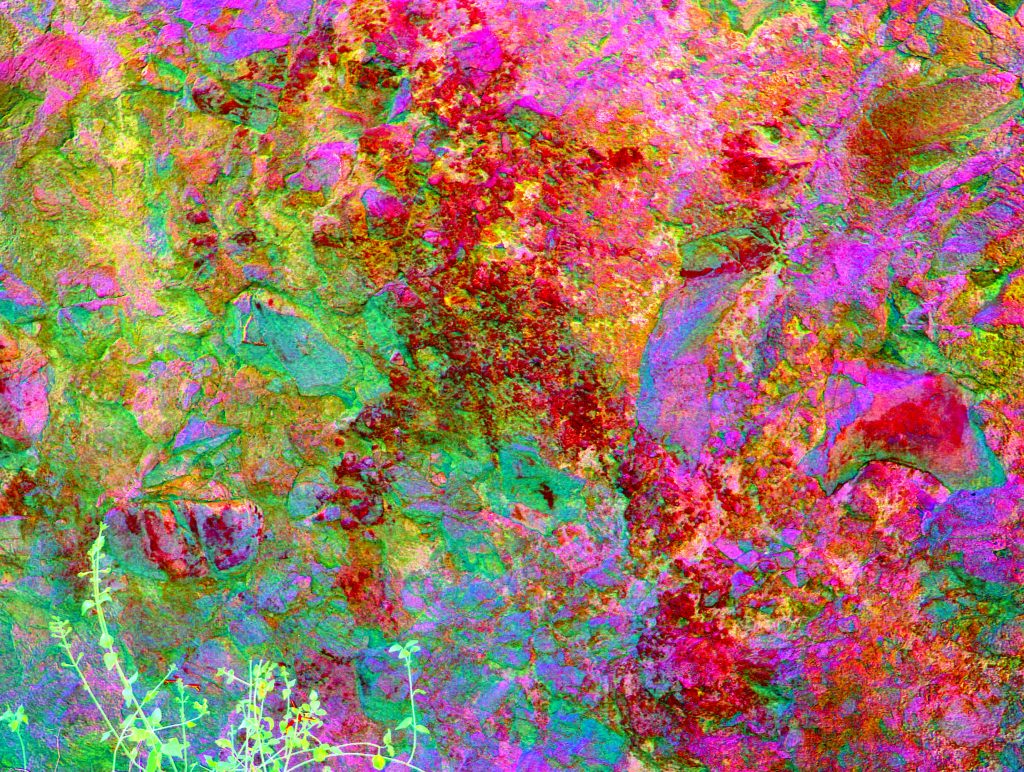
There is a Mono (Mono #9) on this wall about 1.2. meters tall and probably originally completely coloured in red. Very faded. The Mono has its hands up and the legs are bowed. There appears to be a spear penetrating the body, maybe from left to right, There are blobs of colour where hands and feet would be. There may be male genitalia shown but it is very unclear.
Photo: Mono #9_ac_crgb
In its day, this WALL OF MAN would have been very imposing and could not have failed to attract the attention of anyone traversing the arroyo.
Because of the location of these figures in the upper part of Arroyo 4 RIGHT I believe that they were used by the Cochimi clan that were claiming travel and or harvesting rights here, as a deterrent to other Cochimi clans so as to inhibit their travel into the territory downstream. (edit)
There are two other pictograph sites at this location
SB 4R C6b Turtle Rock : about 30 meters before the larger 4RC6 site. There is a large house size rock on the left just as you approach 4RC6 and it has a nice collection of art also. This rock can be identified by the clear pictograph of a turtle with a hand print which is directly facing the arroyo.
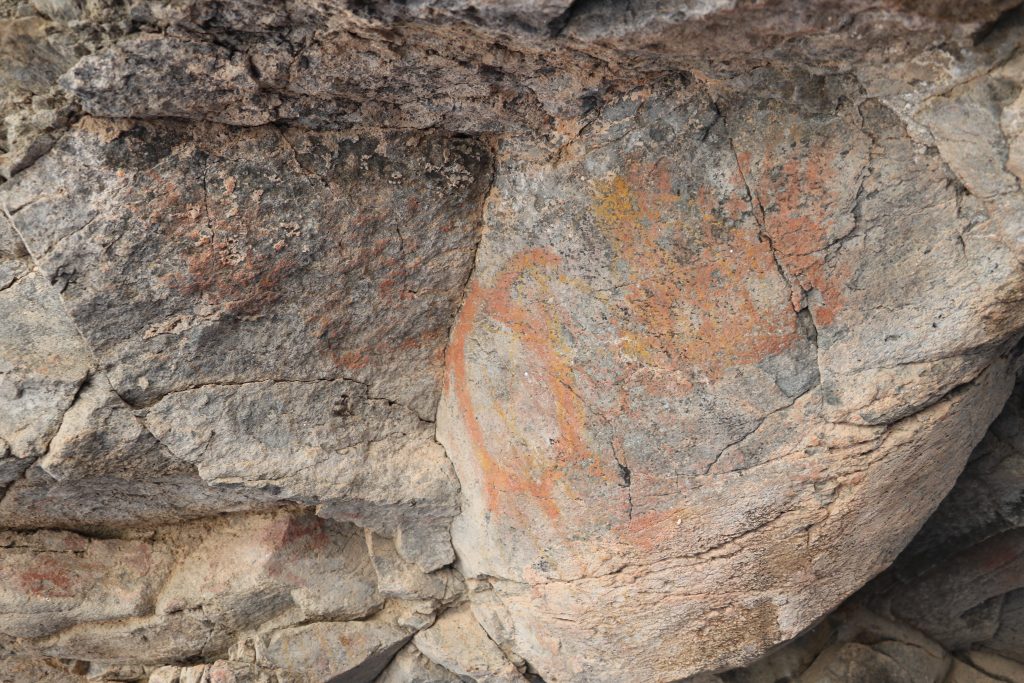
At this location you can see:
Turtle with head facing up, about 18cms long. Outlined in red. There are two red hand prints about 20cms to the right. Both these figures are overlaid with yellow lines? There are faint red figures to the left of the turtle.
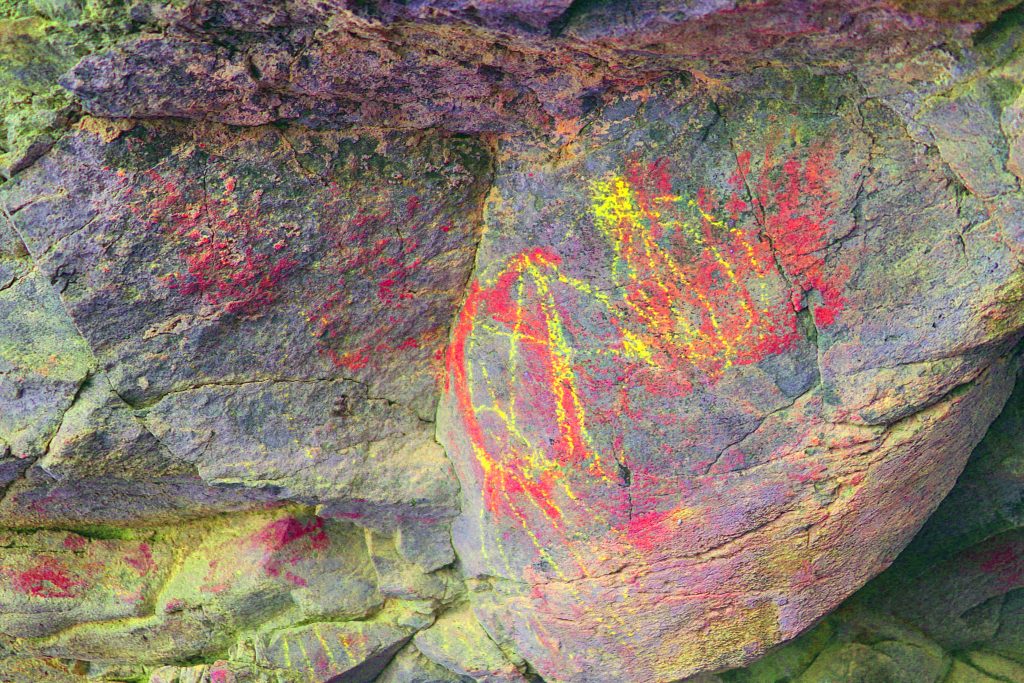
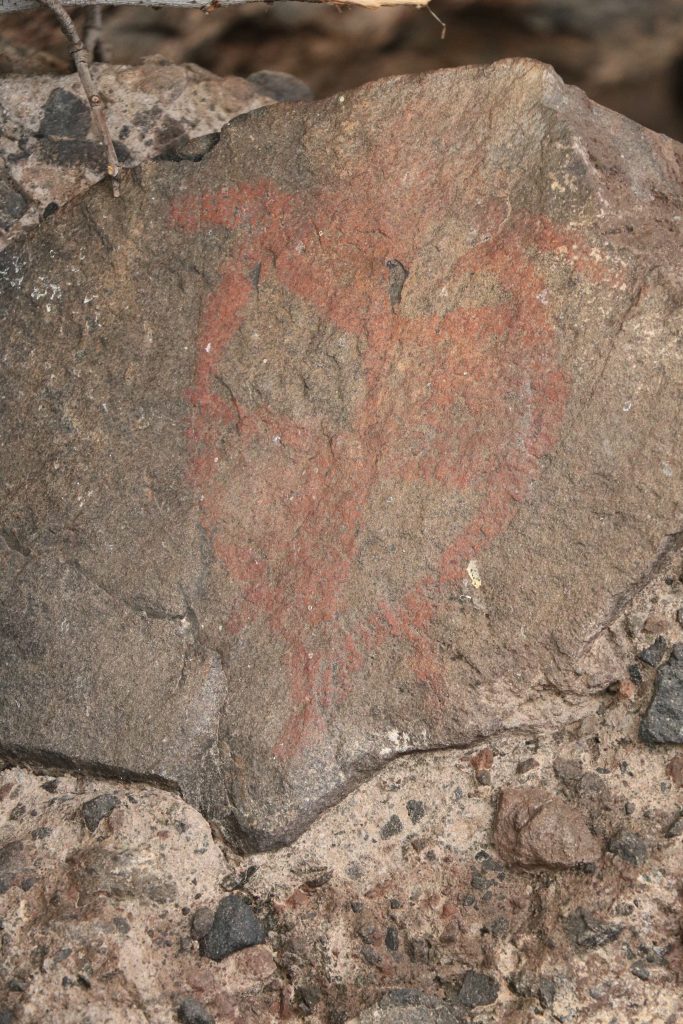
A little to the right, A Turtle with head facing up. This turtle is about 25cms long and is outlined in red with a red and clear checkerboard pattern inside.
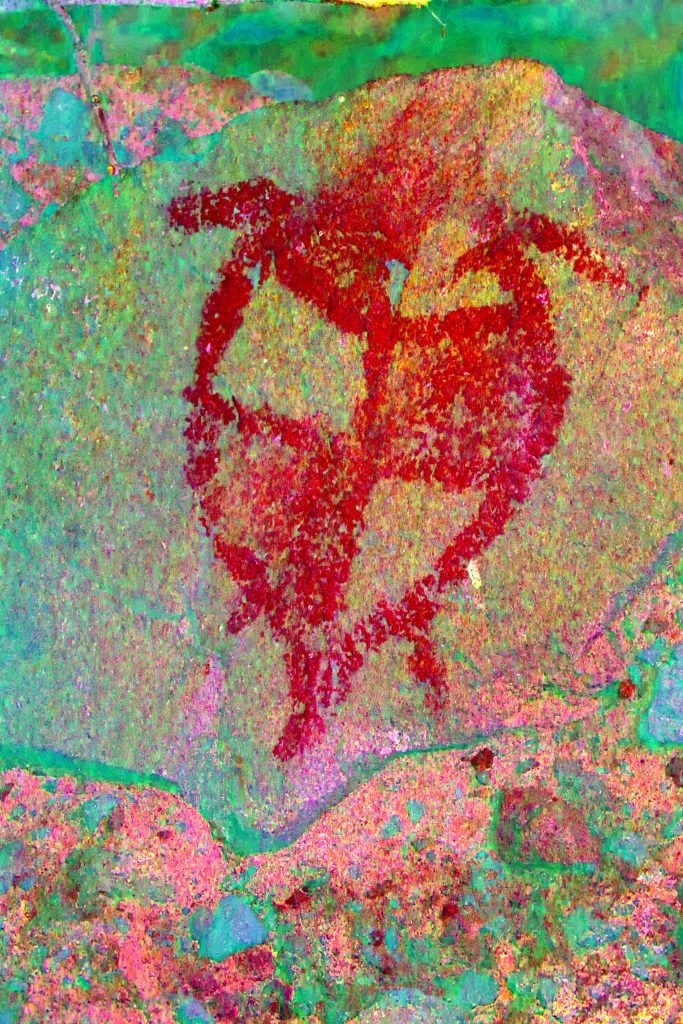
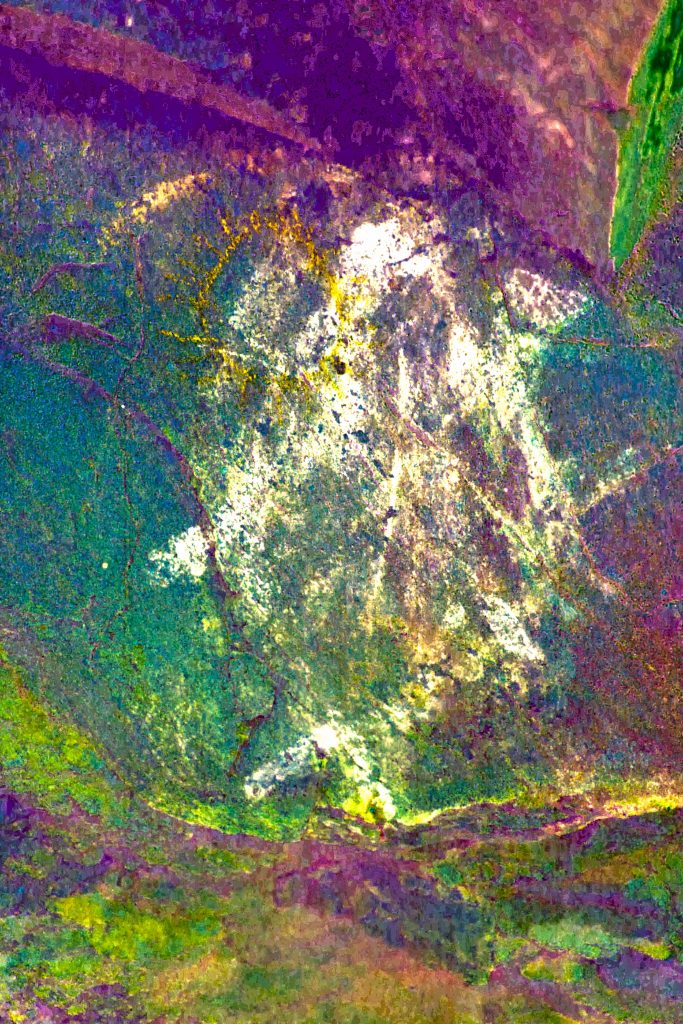
Dstretch ac_labi
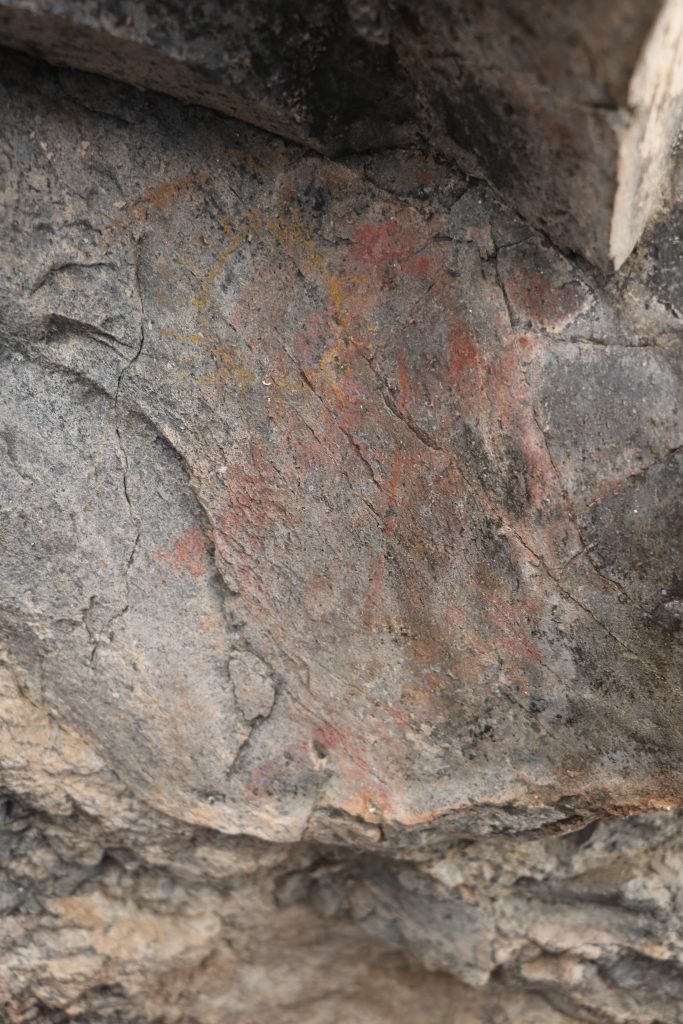
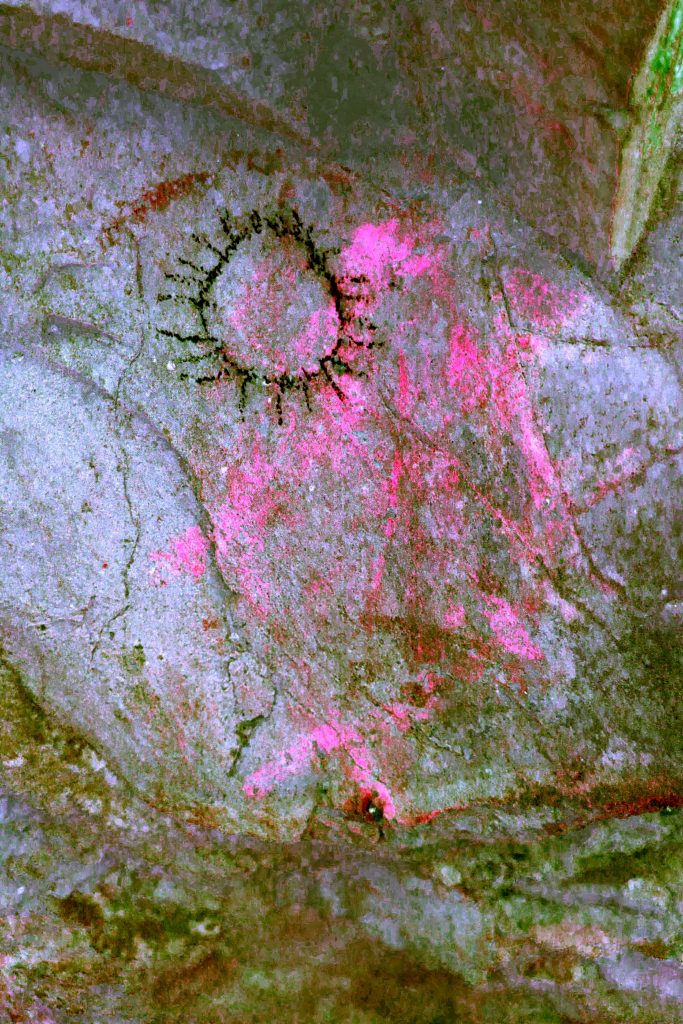
In the pictures above. . . A Pompano style fish in red outline with head up with maybe a short line attached to the mouth and curving to the left. Superimposed on the left shoulder of the fish is a yellow sun about 8cms in diameter with sun rays. This “sun” may be a representation of a Phosphene drawn from the artists perspective (edit).
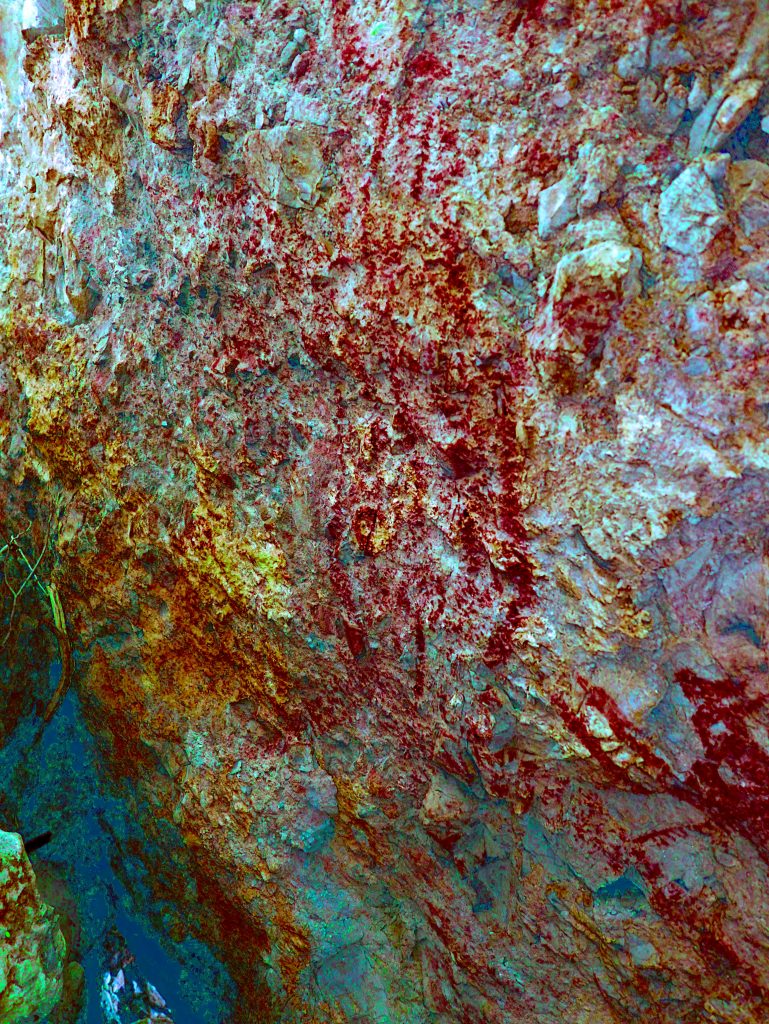
A very faint anthropomorph, seems to be male, about 75cms long, outlined in red with a can style head with vertical lines in head. Vertical lines also in body. There seems to be a fish suspended from the right hand. Fingers are evident on each hand. Male genitals evident, looks like a lollipop.
Photo by author_lrd
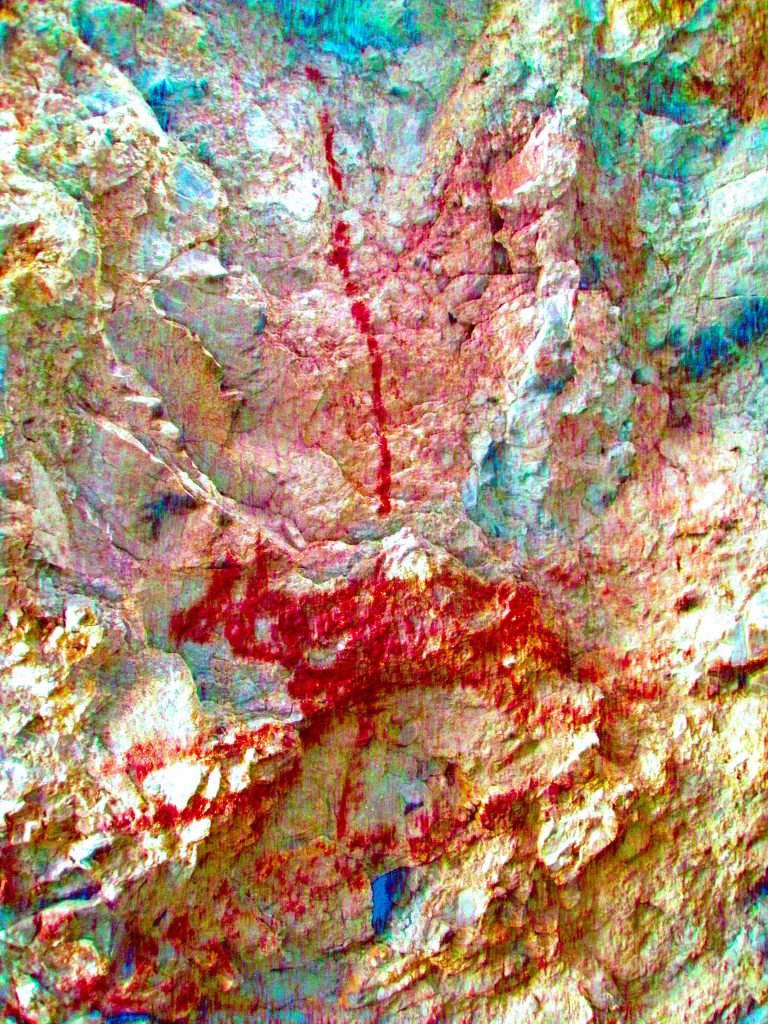
Close to the anthropomorphs left hand and slightly above is a quadruped.
Quadruped, probably deer or rabbit, solid red, about 25cms long, impaled with spear/arrow pointing down through body. Multi-barbs are shown on the lower end of the arrow. Unless you think the spear/dart is going up, in which case they are fletchings
On this ‘Turtle Rock’ there are various handprints in red. And other figures that are not clear.
Photo SB 4R C6b-3_ac_lrd by author
SB 4RC 6a Corn Cob Shelter: On the opposite side of the arroyo from SB 4R C6 is a small south facing shelter about 5 meters wide, 3 meters deep and 4 meters high. The dirt floor of the shelter is only slightly above the level of the arroyo. This shelter also contains art. Rock is a native Andesite type and makes a good solid surface to draw on. There is also a strong presence of shells here, many evident on the surface and more evident on casually scratching the floor of the shelter. The shells are located in the shelter, not in a midden outside. Even although the floor of this shelter is quite close to the level of the arroyo the fact that shells are in abundance indicates that even Chubasco waters do not scour the floor clear.
In this shelter you will find:
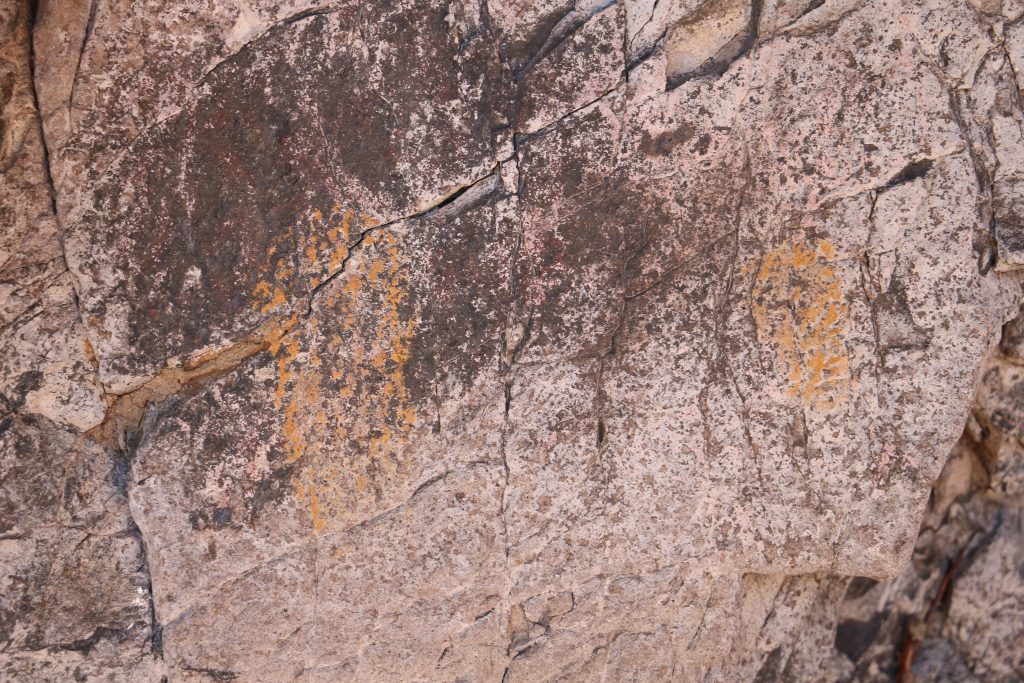
Photo by B. Schweers
Two yellow Corn Cob shapes about 12cms long and 20cms apart.
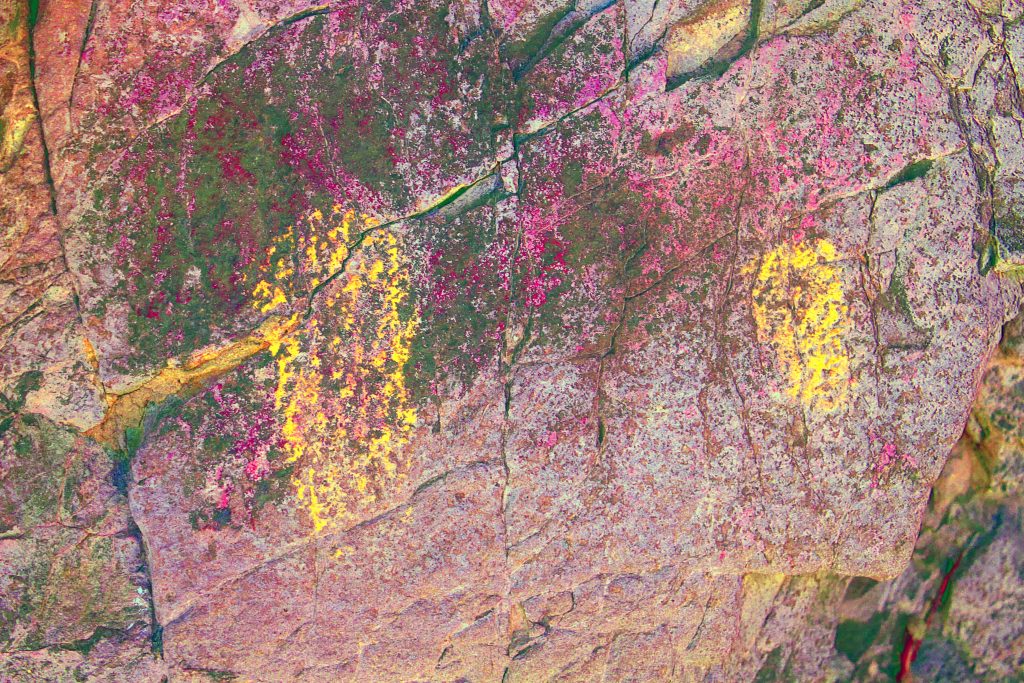
Dstretch ac_ydt
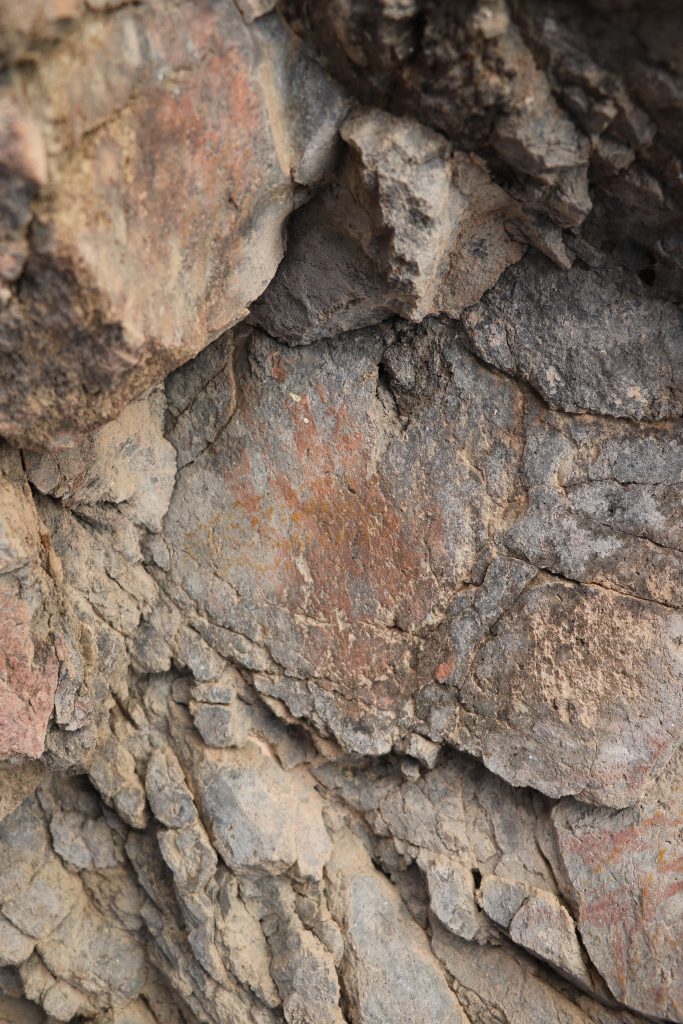
Handprint in solid red overlaid with yellow object. Another mysterious corn cob?
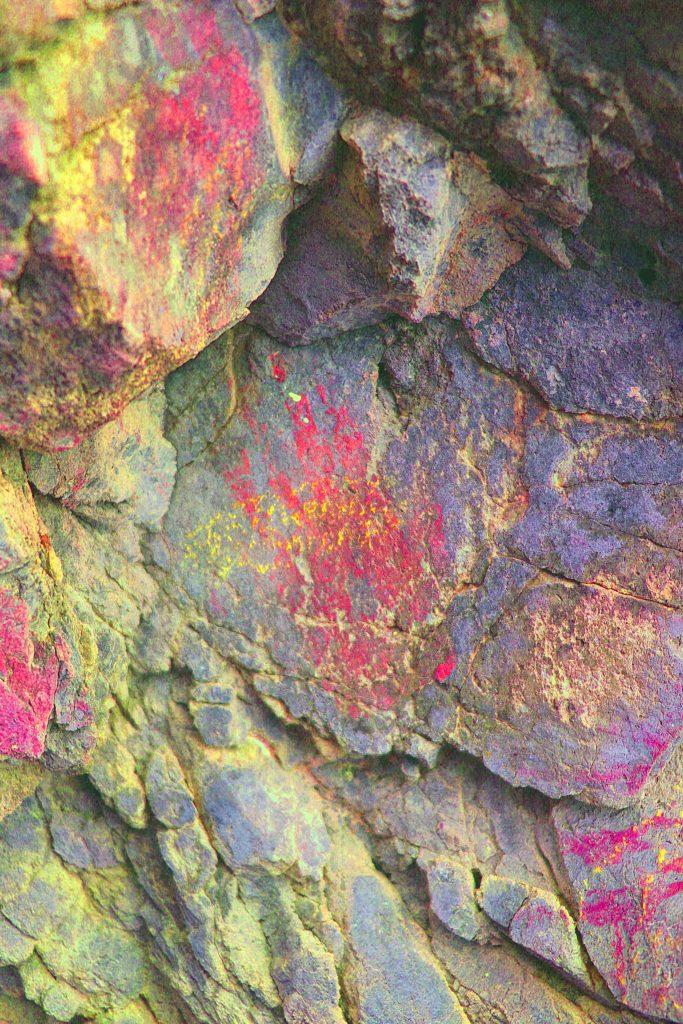
Dstretch ac_ydt
There were other pictographs in this shelter including a non-descript red object overlaid with a faint yellow grid.
Other images present but photos could not be enhanced as they were in bright daylight. One image in black and red at about 1 meter off the floor.
Other images close to the floor of the shelter had red colouring.
Proceding further up the arroyo. . .
Very steep Draw on left at 2.3kms leading up to large north facing overhang at 26.716797, 111.955724 about 70 meters off the arroyo. There is another overhang further up at 26.715766, 111.956807 about 100 meters off the arroyo. One could continue up the wash to the right after looking at the upper overhang to reach a pass at 460 meters into the Mulege basin at 2.9kms and 26.715971, 111.959375
as you progress up the arroyo. . .
The sides of the canyon are still steep and precipitous but at about 2.4kms and about 210 meters altitude the grade of the floor of the arroyo seems to level out somewhat.
Overhangs about 30 meters above arroyo level on left at 2.6kms and 26.719745, 111.957740. One containing a large north facing cave. The approaches to this cave are steep. This cave was explored in 2018 by myself, Terry and Christine. The cave was a large standard cave about 20 meters wide, 4 meters deep with a rough sloping floor not suitable for habitation. There is a large chimney in the cave that opens to the air further up the rock face. Bat droppings was only evidence of animal occurrence.
There are many tinajas here in this part of the arroyo, most still containing water in March. Much of the arroyo bottom is scoured clear of gravel and loose rocks. One part of the canyon floor has reddish coloured base material, probably sandstone, that is quite attractive to see.
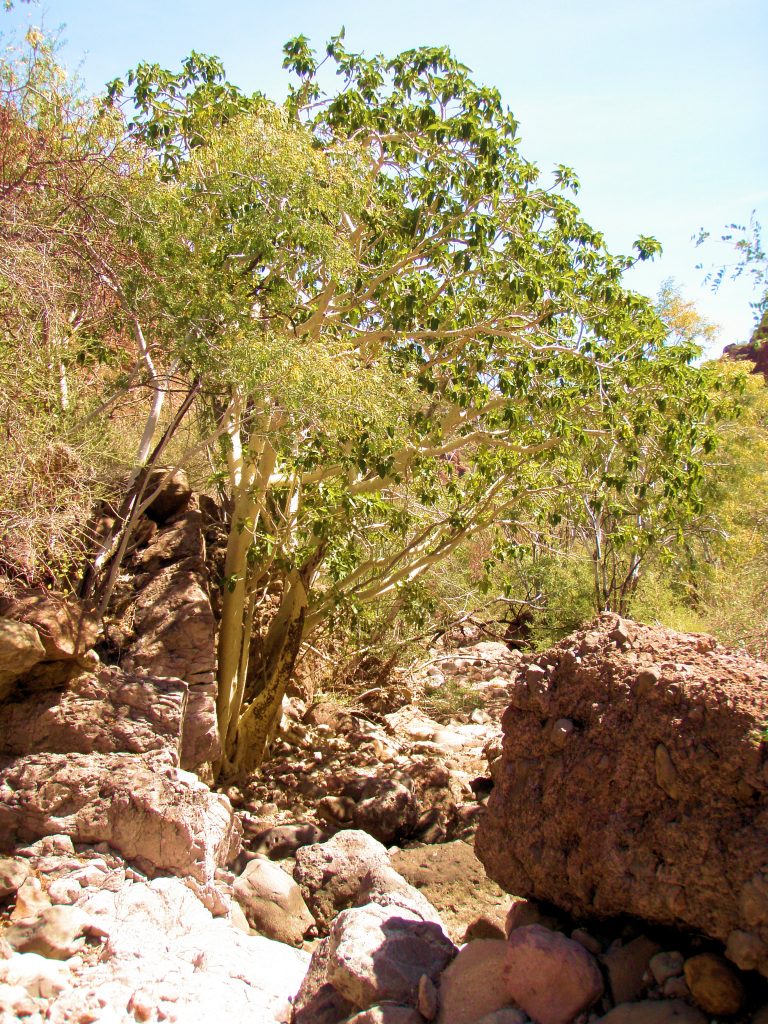
There is abundant tree and cactus growth and occasional agave plants are visible which is not normal at this altitude on the east side of the Baja peninsula. There is a very large (about 10 meters high) wild Fig tree on the right (north) side of the arroyo. This part of the arroyo is quite scenic and comfortable to walk in with few boulders to scramble over.
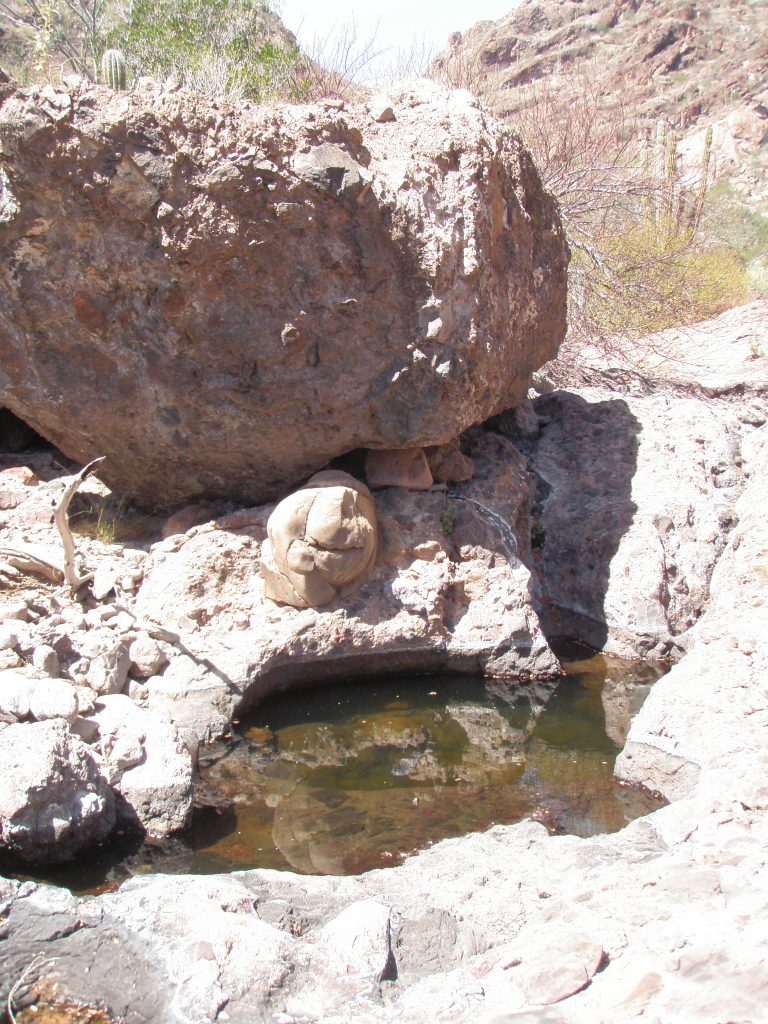
Continuing on to another large house size boulder SB 4R C7 with a 2 meter deep tinaje (holding water in March) alongside at 26.72046, 111.95796 and about 2.8kms from the start of 4R. Altitude here is about 210 meters.
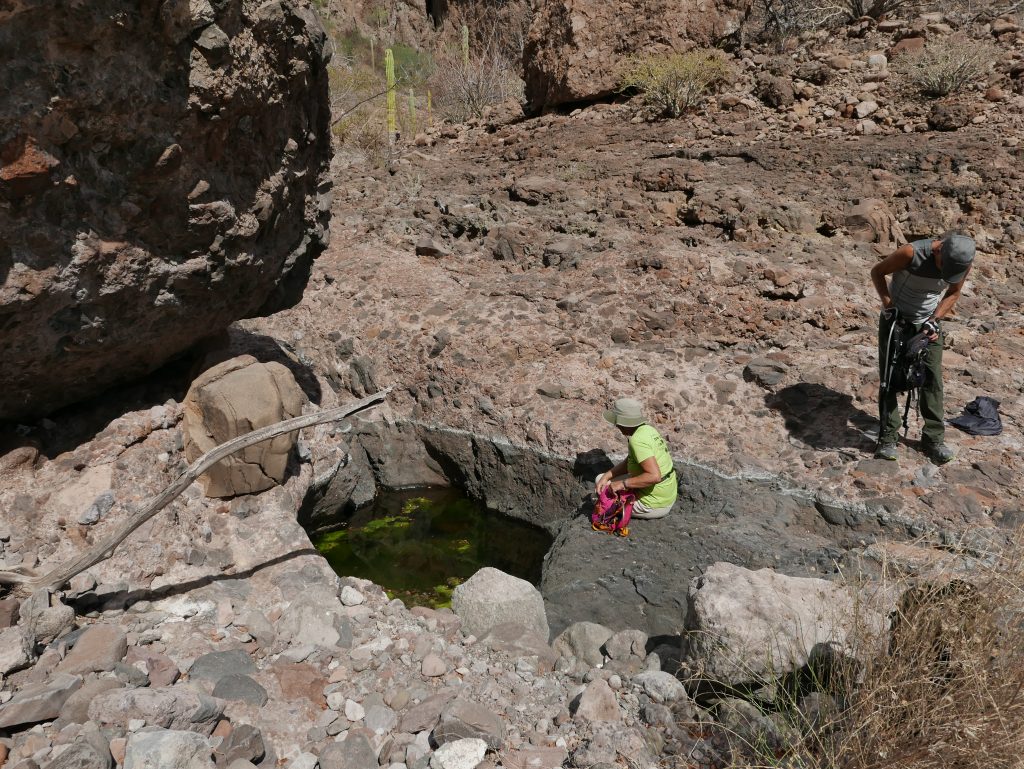
Christine and Terry at SB 4R C7 in 2018. Photo by author
There is art here also. Turtle and others in red. The sides of the boulder show blackening from fires. One time as I approached the pool here, I could swear I saw a large (5cms) Chiton, or something similar, diving down. Do they inhabit fresh water too?
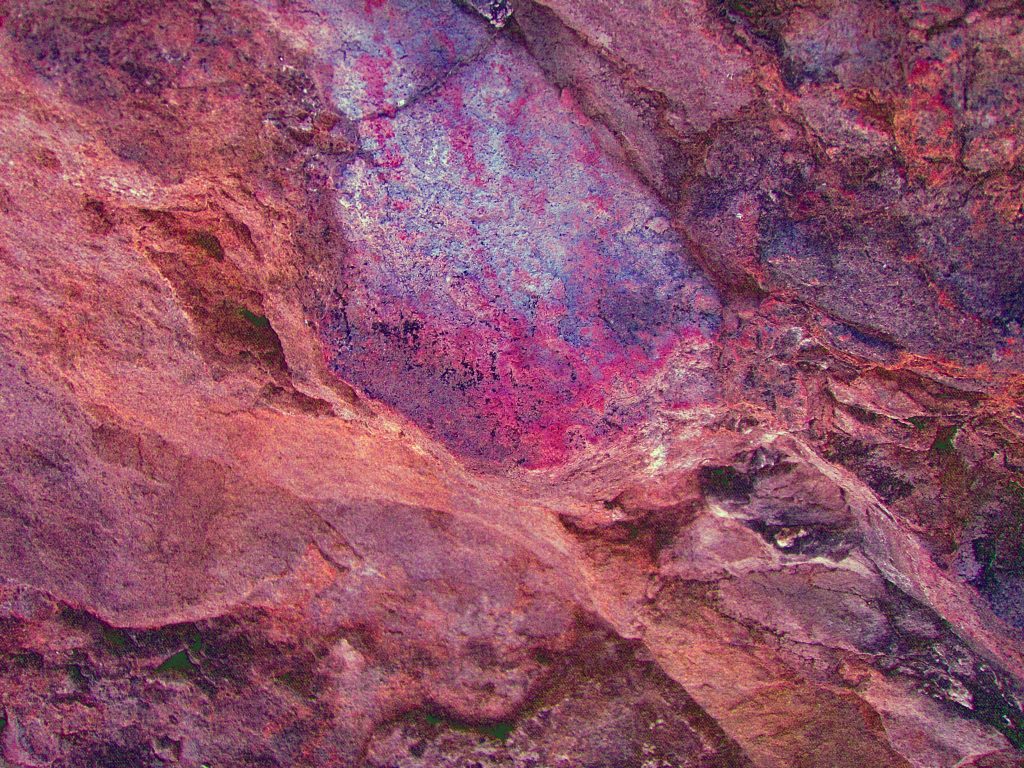
One of the quite nice handprints here. Hard to get a good image because of the bright sun. There is noticeable fire-blackening in at least two places on this boulder.
Photo SB 4R C7-10_ac_rgb0 by author
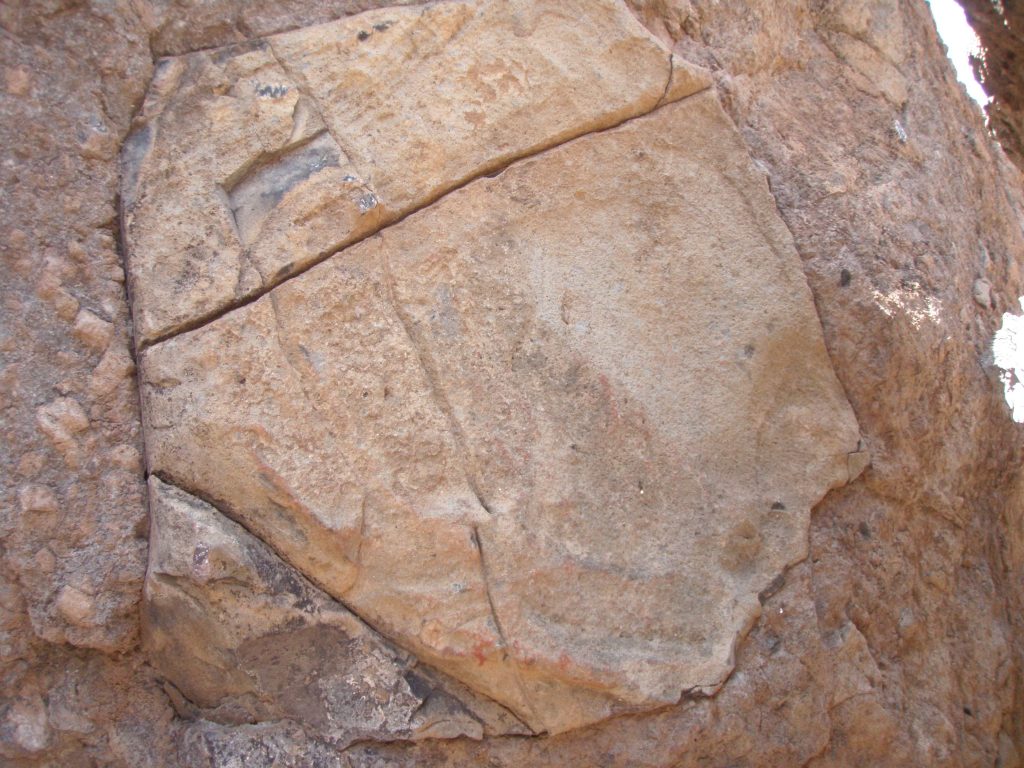
There are also two relatively smooth faced boulders here that might have some scribed lines on them.
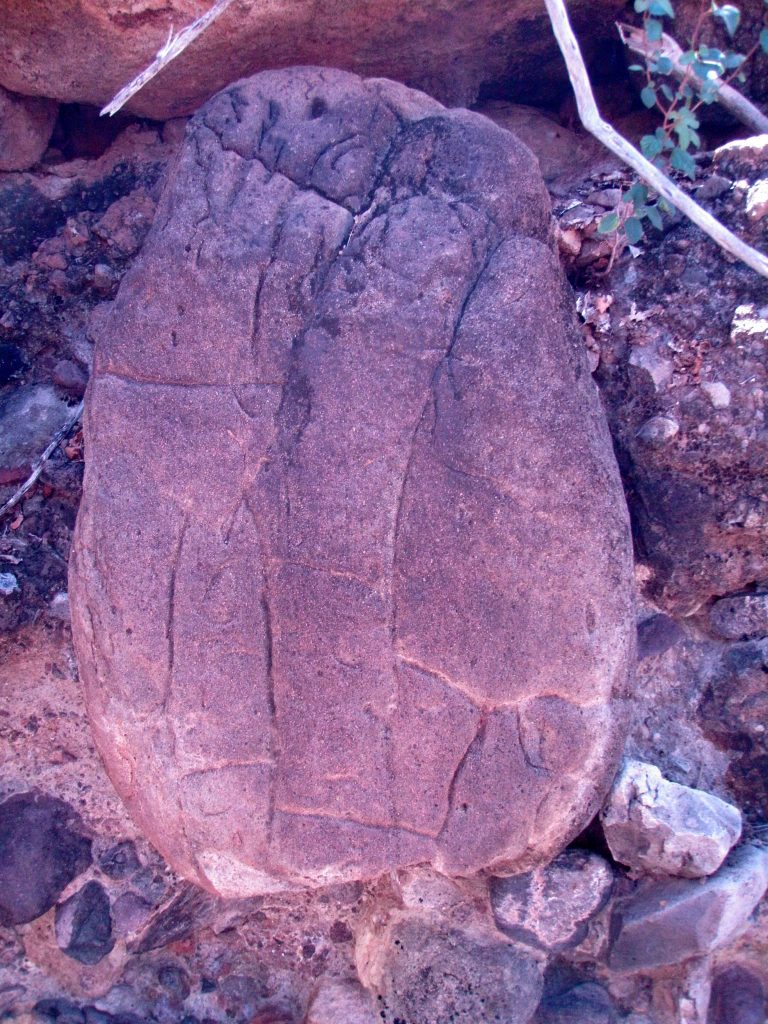
Slightly further up the arroyo:
Draw to left at 2.9kms leading up to many overhangs at 26.719001, 111.959953. There are possibly some caves here but the terrain is rough and steep.
Proceeding about 200 meter further up the arroyo the main arroyo ends and splits into two components No attempt was made to go further.
Draw to right at about 3.0kms and 26.722314, 111.960263 at 280 meters elevation leading northward through massive tumbled and fractured rock which is steep, rough and heavily populated with trees and shrubs. This draw eventually attains height of land at more or less the same point as 5 RIGHT.
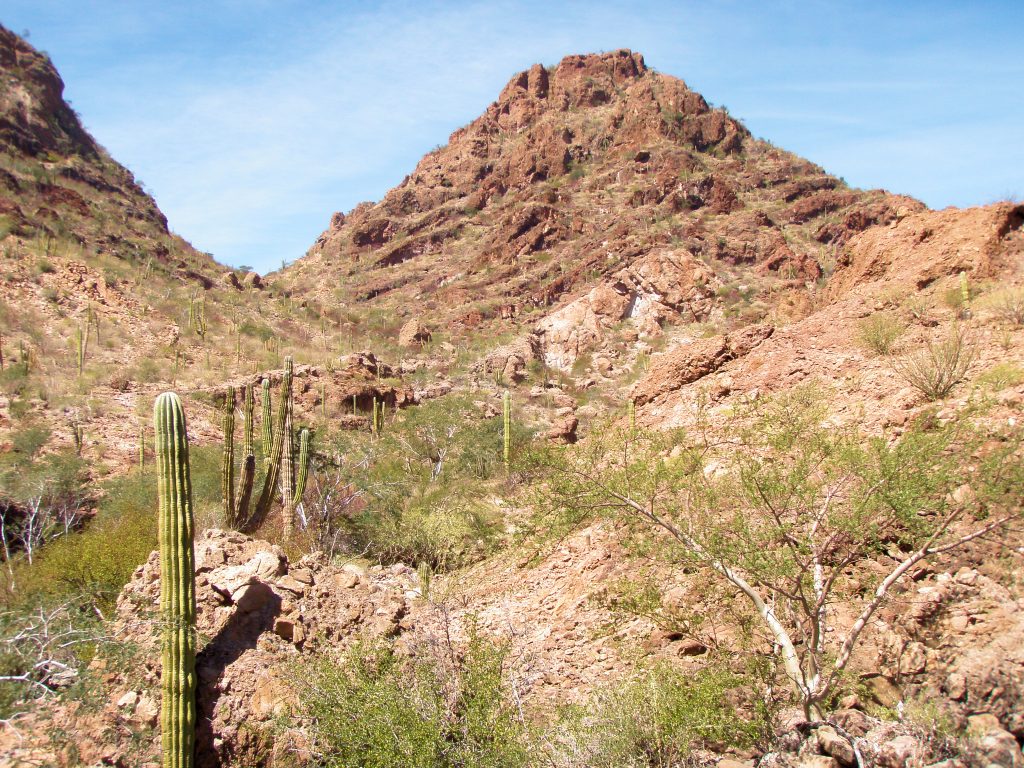
Pass is evident in left draw and is also rough going and heavily covered with trees and shrubs. Pass is at about 380 meters at 3.6kms and 26.722564, 111.963952. Pass leads into the Mulege drainage basin.
Here we turned around and headed back to camp. From here we noted that we were only about 1.6kms from a place in the Mulege basin where a vehicle could be parked.
This concludes the initial exploration of the Santa Barbara tributary, named by the author, 4 RIGHT. There are many other prospect caves and shelters in this tributary that when examined, could produce evidence of Cochimi use.
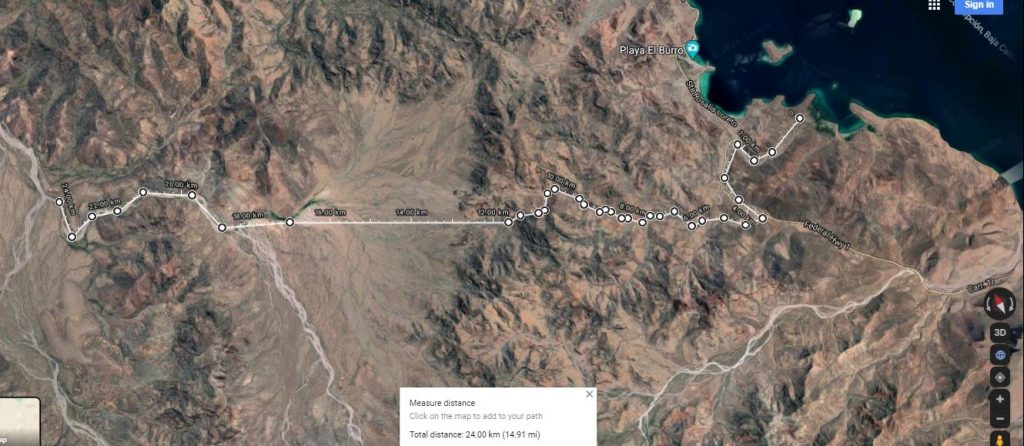
I believe that this tributary was one of the significant routes used by the Cochimi in their seasonal journeys between the beaches of Conception Bay and the mountains of the Guadalupe Sierras. This is supported by:
- The permanent pools of water in three locations in the arroyo.
- Numerous sites with art work in the upper reaches of this tributary.
- A relatively low altitude Pass to the Mulege Basin.
- A fairly direct route of 24kms or so, from the beaches to the Piedras Pintados site.
- Fire blackening at sites with water present, about half-way between the beaches and Piedras Pintados. Suggesting overnight stays.
David Symington March and February 2018.
